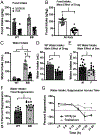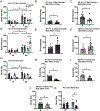The role of glucagon-like peptide-1 (GLP-1) in fluid and food intakes in vasopressin-deficient Brattleboro rats
- PMID: 36706972
- PMCID: PMC9974868
- DOI: 10.1016/j.physbeh.2023.114093
The role of glucagon-like peptide-1 (GLP-1) in fluid and food intakes in vasopressin-deficient Brattleboro rats
Abstract
Eating and drinking co-occur and many of the same mechanisms that control one are involved in the control of the other, making it difficult to isolate specific mechanisms for the control of fluid intake. Glucagon-like peptide-1 (GLP-1) is a peptide that seems to be involved in the endogenous control of both ingestive behaviors, but we lack a thorough understanding of how and where GLP-1 is acting to control fluid intake. Vasopressin-deficient Brattleboro rats are a model of hereditary hypothalamic diabetes insipidus that have been used extensively for the study of vasopressin actions in behavior and physiology. Here, we propose that these rats, that eat normally but drink excessively, provide a useful model to dissociate central controls of food and fluid intakes. As an initial step toward establishing this model for these purposes, we focused on GLP-1. Similar to the effect observed after treatment with a GLP-1 receptor (GLP-1R) agonist, the intake difference between wildtype and Brattleboro rats was largely a function in the number of licking bursts, indicating differences in post-ingestive feedback (e.g., satiation). When given central injections of a GLP-1R agonist, the effect on feeding was comparable between wildtype and Brattleboro rats, but the effect of drug on fluid intake was markedly exaggerated in Brattleboro rats. Additionally, Brattleboro rats did not respond to GLP-1R antagonism, whereas wildtype rats did. Taken together, these results suggest that Brattleboro rats exhibit a selective disruption to GLP-1's control of water intake. Overall, these experiments provide foundational studies of the ingestive behavior of Brattleboro rats and demonstrate the potential to use these rats to disentangle the effects of GLP-1 on food and fluid intakes.
Keywords: Drinking; Feeding; Glucagon-like peptide-1; Polydipsia; Thirst.
Copyright © 2023 Elsevier Inc. All rights reserved.
Conflict of interest statement
Declaration of Competing Interest The authors have no competing interests and no conflicts nothing to disclose.
Figures







References
Publication types
MeSH terms
Substances
Grants and funding
LinkOut - more resources
Full Text Sources
Research Materials

